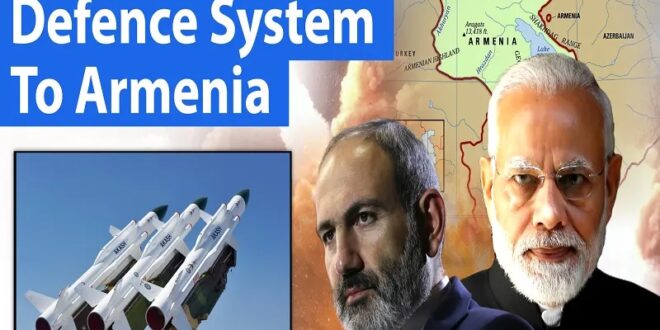Unlike the US and France, which are taking the lead in the West’s efforts to lure Armenia away from Russia for regional divide-and-rule purposes, neither India nor Iran believes that their actions in correspondingly exporting such wares to Armenia and facilitating them destabilize the region.
The West exploited Azerbaijan’s back-to-back military victories over Armenia to lure the latter away from Russia, which has taken the form of Yerevan informally suspending participation in the CSTO. Its geopolitical pivot is dangerous since the replacement of Russian security guarantees and weapons with Western ones could lead to the second one day supporting Armenian revanchism for regional divide-and-rule purposes. It’s therefore important for this emerging trend to be responsibly managed.
Indian-Armenian military ties began to expand after the 2020 war but have once again made the news amidst reports that Delhi plans to send Yerevan Akash short-range surface-to-air missiles (SAMs). India’s military-industrial exports are small, so Armenia is considered an important place to prove their worth to others. From Armenia’s perspective, gradually replacing Russian weapons with a combination of Indian and Western ones can help preemptively avert potentially disproportionate dependence on the latter.
This convergence of interests explains the immediate reasons behind their military-industrial cooperation, but there are other factors to consider as well. Iran has an interest in facilitating India’s role in Armenia’s admittedly clumsy de facto post-CSTO balancing act, ergo why any such exports are expected to pass through its territory en route to that country. Considering this strategic imperative, it therefore wouldn’t be surprising if Iran also one day exports its own military-industrial wares to Armenia.
Unlike the US and France, which are taking the lead in the West’s efforts to lure Armenia away from Russia for regional divide-and-rule purposes, neither India nor Iran believes that their actions in correspondingly exporting such wares to Armenia and facilitating them destabilize the region. To the contrary, they conceptualize their respective policies as helping to gently balance growing Western influence over Armenia in general and over its armed forces in particular.
That said, there’s also no denying that India’s ties with Azerbaijan and Turkiye aren’t all that good after those two took Pakistan’s side in the Kashmir Conflict, while Iran’s ties with them haven’t been the best either. For that reason, it’s understandable why they might perceive India’s reportedly planned military-industrial exports and Iran’s foreseeable facilitation of them as posing threats to their interests, which aligns with the security dilemma concept of International Relations theory.
To briefly explain, this preaches that one country’s self-perceived defensive moves could easily be seen by others like their rivals as secretly driven by offensive intentions, thus prompting those who interpret developments that way to undertake their own self-perceived defensive moves. These are in turn seen by the first country as secretly driven by offensive intentions as well, which prompts them to react, and so on and so forth in a very dangerous cycle of mutual escalations.
India appears to be aware of how Azerbaijan and Turkiye perceive its reportedly planned military-industrial exports to Armenia, however, as suggested by Akash being defensive short-range SAMs and not offensive HIMARS-like ones. To be sure, such defensive weapons could also indirectly have offensive purposes if they bolster the host country’s defense enough to embolden them to carry out offensive actions with expected impunity, but India doesn’t anticipate Akash being used by Armenia that way.
By contrast, France’s similarly planned SAM exports to Armenia are driven by the desire to rope that country into NATO’s military-industrial complex of weapons, technicians, and advisors, and the deaths of their support personnel in any potential conflict could serve as the tripwire for intervention. This difference between France’s membership in NATO and India’s military neutrality accounts for why there are more reasons to be suspicious of the first’s motives for selling SAMs to Armenia than the second’s.
Returning back to International Relations theory, Armenia claims that Azerbaijan and Turkiye pose the most credible threats to its security, which isn’t true since neither has any territorial claims over that country but is nevertheless the paradigm through which Yerevan is formulating policy. Since Armenia was misled into regarding Russia as an unreliable security partner and replacing it with the West, whose intentions are to divide-and-rule the region, Azerbaijan and Turkiye’s security is now jeopardized.
If Armenia fully pivots towards the West, which for all intents and purposes means NATO (with whom fellow member Turkiye’s ties are strained), then it could create far-reaching security challenges for Azerbaijan and Turkiye. Unless Pashinyan has a change of heart or is replaced (whether democratically or otherwise) by someone who reverses his country’s present military-strategic trajectory, then they can’t stop this trend since all NATO arms and personnel would transit through Georgia to Armenia.
Neither Azerbaijan nor Turkiye will go to war against Georgia to cut off NATO-Armenian relations, so absent the aforesaid best-case scenarios of Yerevan reversing this policy, the next best one is that it becomes serious about preemptively averting disproportionate dependence on that bloc. More Indian military-industrial exports and Iran’s facilitation of them, not to mention the possibility of dispatching its own there one day too, could serve as practical means to that end.
Just like with Georgia vis-à-vis its role in facilitating NATO-Armenian relations, neither Azerbaijan nor Turkiye will go to war against Iran to cut off Indian-Armenian relations, thus meaning that these strategically significant corridors are a fait accompli for those two to accept. In these circumstances, their interests are best served by Armenia’s military ties with neutral India and Iran balancing its ones with NATO’s American and French members, but this can only happen if Yerevan has the will to do so.
Objectively speaking, that country is tilting much closer towards NATO in the military sense nowadays than towards India-Iran, and it might be that Armenia’s reportedly planned Akash imports are intended to deflect from what could really be its secret decision to carry out a full-blown pivot towards NATO. At the same time, there’s no denying that operating two completely separate types of SAMs is difficult and complicates military operations, which would mean that this is a counterproductive distraction if true.
With that observation in mind, it arguably appears that Armenia hasn’t yet decided to fully pivot towards NATO even though it’s tilting much closer towards it after informally suspending participation in the CSTO, ergo why it reportedly wants India’s Akash instead of relying on French SAMs to replace Russia’s. At the end of the day, since Azerbaijan and Turkiye can’t cut off NATO-Armenian relations nor Indian-Armenian ones, the best that they can hope for is that Yerevan is sincere about balancing between them.
 Eurasia Press & News
Eurasia Press & News



